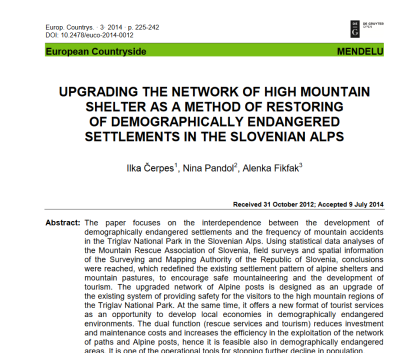Digital library
Showing results 12 - 14/14
Upgrading the Network of High Mountain Shelter as A Method of Restoring of Demographically Endangered Settlements in the Slovenian Alps
The paper focuses on the interdependence between the development of demographically endangered settlements and the frequency of mountain accidents in the Triglav National Park in the Slovenian Alps. Using statistical data analyses of the Mountain Rescue Association of Slovenia, field surveys and spatial information of the Surveying and Mapping Authority of the Republic of Slovenia, conclusions were reached, which redefined the existing settlement pattern of alpine shelters and mountain pastures, to encourage safe mountaineering and the development of tourism. The upgraded network of Alpine posts is designed as an upgrade of
the existing system of providing safety for the visitors to the high mountain regions of the Triglav National Park. At the same time, it offers a new format of tourist services as an opportunity to develop local economies in demographically endangered environments. The dual function (rescue services and tourism) reduces investment and maintenance costs and increases the efficiency in the exploitation of the network of paths and Alpine posts, hence it is feasible also in demographically endangered areas. It is one of the operational tools for stopping further decline in population.
Source
COBISS, De Gruyter Open, De Gruyter Poland
Year
2014
Type
Original scientific article
Format
Document (PDF, DOC, ...)
Authors
Ilka Čerpes, Nina Pandol, Alenka Fikfak
Keywords
Demographically endangered settlements, mountain accidents, Triglav National Park, hiking, tourist development, Alpine settlement, Alpine huts and shelters
Območja
Triglav National Park, Alps
Phytosociological analysis of riverine forests along the Sava Bohinjka, Radovna, Učja and Slatenik Rivers in northwestern Slovenia
Applying the standard Central-European method we conducted a phytosociological study of riverine forests along the rivers Sava Bohinjka, Radovna, Učja and the Slatenik brook in northwestern Slovenia and compared them to similar riverine forests in the Soča river basin and the neighbouring countries of Croatia, Austria and Italy. Based on this comparison they were classified into the following syntaxa: Salicetum eleagno-purpureae, Salicetum albae,
Lamio orvalae-Salicetum eleagni (also in the new subassociation -caricetosum eletae) and Lamio orvalae-Alnetum incanae (also in the new subassociation -fraxinetosum excelsioris and -rhamnetosum fallacis). We described successive replacement (zonation) of communities along the Sava Bohinjka from initial gravel beds towards beech communities on higher lying river terraces. Applying the phytoindication method we evaluated the production capacity
of economically the most valuable type of the studied riverine forests, stands of the subassociation Lamio orvalae-Alnetum incanae fraxinetosum excelsioris.
Source
Digitalna knjižnica Slovenije, Slovenska akademija znanosti in umetnosti
Year
2013
Type
Thesis
Format
Website
Authors
Igor Dakskobler, Andrej Rozman
Keywords
Phytosociology, synsystematics, Alnion incanae, phytoindication, Natura 2000, Bohinj, Julian Alps, Triglav national park, Slovenia
Območja
Triglav National Park, Alps, Slovenia


